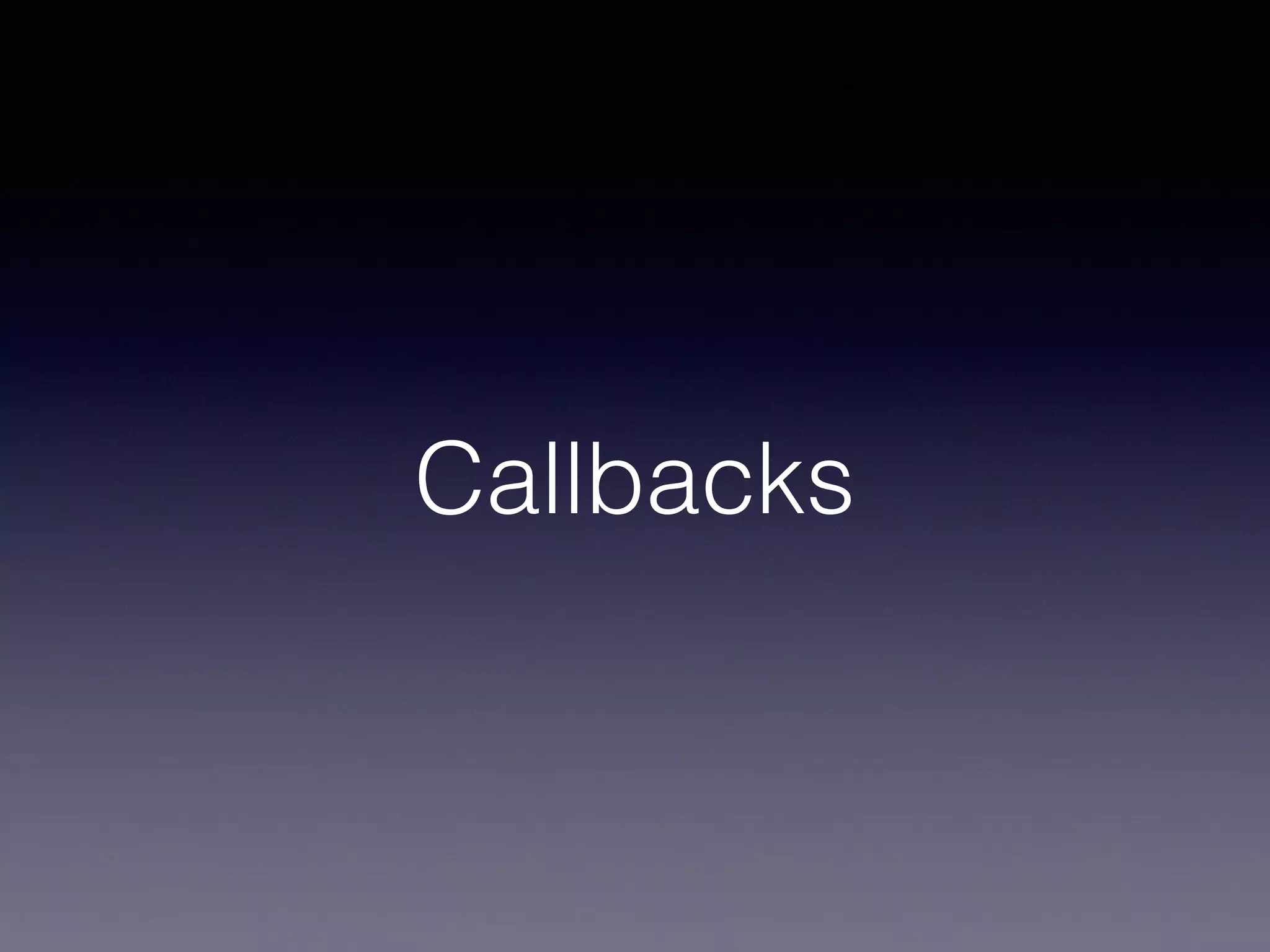The document provides an introduction to asynchronous JavaScript. It discusses callbacks and their disadvantages like callback hell. Promises are introduced as a better way to handle asynchronous code by making it easier to write and chain asynchronous operations. Async/await is described as syntactic sugar that allows asynchronous code to be written more readably in a synchronous style using await and try/catch. Key aspects like the event loop, microtask queue, and Promise methods like all and race are explained. Overall the document aims to help understand what makes asynchronous code different and newer methods like promises and async/await that improve handling asynchronous operations in JavaScript.






























![The AJAX Way
[
{
"id": 1,
"name": "Leanne Graham",
"username": "Bret",
"email": "Sincere@april.biz",
"address": {
"street": "Kulas Light",
"suite": "Apt. 556",
"city": "Gwenborough",
"zipcode": "92998-3874",
"geo": {
"lat": "-37.3159",
"lng": "81.1496"
}
},…
]](https://image.slidesharecdn.com/asyncjavascript2-191108171249/75/Intro-to-Asynchronous-Javascript-31-2048.jpg)


![Callback Hell
$.ajax({
url: 'https://jsonplaceholder.typicode.com/users',
success: function(data) {
const target = data[4];
const id = target.id;
$.ajax({
url: `https://jsonplaceholder.typicode.com/posts?userId=${id}`,
success: function(data) {
console.log(data)
},
error: function(request, error) {
console.log(error)
},
dataType: 'json'
});
},
error: function(request, error) {
console.log(error)
},
dataType: 'json'
});](https://image.slidesharecdn.com/asyncjavascript2-191108171249/75/Intro-to-Asynchronous-Javascript-34-2048.jpg)





![Callback Hell
$.ajax({
url: 'https://jsonplaceholder.typicode.com/users',
success: function(data) {
const target = data[4];
const id = target.id;
$.ajax({
url: `https://jsonplaceholder.typicode.com/posts?userId=${id}`,
success: function(data) {
console.log(data)
},
error: function(request, error) {
console.log(error)
},
dataType: 'json'
});
},
error: function(request, error) {
console.log(error)
},
dataType: 'json'
});](https://image.slidesharecdn.com/asyncjavascript2-191108171249/75/Intro-to-Asynchronous-Javascript-40-2048.jpg)
![With Promises…
fetch("https://jsonplaceholder.typicode.com/users")
.then(result => result.json())
.then(data => {
let id = data[4].id;
return fetch(`https://jsonplaceholder.typicode.com/
posts?userId=${id}`);
})
.then(result => result.json())
.then(posts => console.log(posts))](https://image.slidesharecdn.com/asyncjavascript2-191108171249/75/Intro-to-Asynchronous-Javascript-41-2048.jpg)









![Promise.all()
fetch("https://jsonplaceholder.typicode.com/users")
.then(result => result.json())
.then(data => {
let id = data[4].id;
return fetch(`https://jsonplaceholder.typicode.com/posts?userId=${id}`);
})
.then(result => result.json())
.then(posts => posts.map(post => fetch(`https://jsonplaceholder.typicode.com/
comments?postId=${post.id}`)))
.then(promiseArr => Promise.all(promiseArr))
.then(responses => Promise.all(responses.map(response => response.json())))
.then(results => console.log(results))](https://image.slidesharecdn.com/asyncjavascript2-191108171249/75/Intro-to-Asynchronous-Javascript-51-2048.jpg)





![Refactoring
async function getComments() {
let users = await fetch("https://jsonplaceholder.typicode.com/users");
users = await users.json();
let id = users[4].id;
let posts = await fetch(`https://jsonplaceholder.typicode.com/posts?userId=${id}`);
posts = await posts.json();
let promiseArr = posts.map(post => await fetch( `https://jsonplaceholder.typicode.com/
comments?postId=${post.id}`));
let comments = await Promise.all(promiseArr)
comments = await Promise.all(comments.map(comment => comment.json()))
console.log(comments)
}
getComments()](https://image.slidesharecdn.com/asyncjavascript2-191108171249/75/Intro-to-Asynchronous-Javascript-57-2048.jpg)
![Even cleaner
async function getComments() {
let users = await (await fetch("https://jsonplaceholder.typicode.com/users")).json();
let id = users[4].id;
let posts = await (await fetch(`https://jsonplaceholder.typicode.com/posts?userId=$
{id}`)).json()
let comments = await Promise.all(
posts.map(async (post) => await (await fetch( `https://jsonplaceholder.typicode.com/
comments?postId=${post.id}`)).json())
)
console.log(comments)
}
getComments()](https://image.slidesharecdn.com/asyncjavascript2-191108171249/75/Intro-to-Asynchronous-Javascript-58-2048.jpg)



